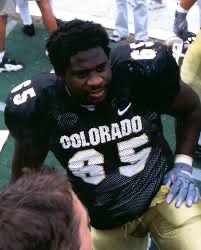
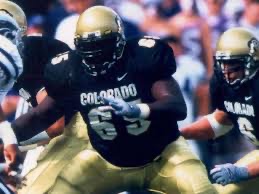
Note from site: This is a reprint of a post from 2 weeks ago to give Buff Fans something to read over their beautiful Colorado weekend. Happy Friday! Since the original publishing date, CU has named Gunnar White as head offensive line coach and brought former CU great Andre Gurode back to Boulder as an assistant offensive line coach. Naming White as lead offensive line coach leaves a lot of questions — hopefully hiring Gurode answers some of those questions.
Colorado’s offensive line was average last year.
Pick your jaw up off the floor and read that again.
Colorado’s offensive line was average last year.
According to Pro Football Focus, CU had the 51st highest pass blocking score in the country (out of 134 schools) and the 77th highest run blocking score in the country. If we average these out, Colorado’s offensive line was ranked 64th in the country — just above the 50th percentile nationally.
Now, this doesn’t mean that there’s not material work to do on the offensive line. The offensive line had a difficult time moving bodies out of the way in the run game, and Shedeuer Sanders was sacked too often. Sanders was sacked 42 times over 13 games for an average of 3.2 sacks allowed, which was among the highest rates in the nation. Still, the perception of the offensive line’s performance last year is worse than their actual performance — and said perception is exacerbated by the fact that Sanders had a tendency to hold onto the ball too long and get sacked.
Despite this tendency, the Buffs are going to really miss Sanders. Without a generational talent at QB and WR this upcoming season, the offensive line will need to take a giant leap forward if Colorado’s offense is going to continue to be the strength of the team. To put it frankly — Colorado is going to need to be able to run the ball this season, and the Buffs couldn’t effectively run the ball last season. Colorado could only average 2.6 yards per carry, and 63 rushing yards a game. This isn’t good enough.
Unfortunately, it’s not obvious that the talent level of the upperclassmen offensive lineman has been materially increased with the transfer class. Most of the improvement will probably need to be incremental improvement among returnees. In this post, we’ll look at the overall state of the offensive line from a scholarship and coaching standpoint. We’ll then look at the returning offensive lineman and break down which returnees will, likely, be key components of the line in 2025. We’ll then turn our attention to the transfer class and see which transfers will be likely to make an impact this upcoming season. We’ll then conclude by predicting a likely 2-deep for the 2025 season.
State of the Offensive Line:
Most Power 4 teams carry between 14 to 18 offensive linemen, including developmental (non-scholarship) players. In the 2024 season, for example, Michigan, Alabama, Georgia and Penn State each had 14 scholarship offensive linemen on their roster with an additional 2-3 developmental walk-ons.
As of today, Colorado looks to have 13 offensive linemen on scholarship. Note, however, that this number does not include Cash Cleveland or Ben Reznik, both of whom saw material playing time last fall and may be in line for a scholarship.
Additionally, Colorado still needs to sign a head offensive line coach. Phil Loadholt left Colorado this off-season to take the reigns as the offensive line coach at Mississippi State (“Enjoy Stark-Vegas, coach!,” he snickers). Colorado does have 2 assistant offensive line coaches already lined up —- Gunnar White and part-time coach / part-time Sherman Tank George Hegamin (check out https://buffsblog.com/buffblog-bites/ for more on their coaching backgrounds).
It’s possible that whoever is named offensive line head coach may bring transfer linemen with him. Colorado saw this in 2023 when former offensive line coach Bill O’Boyle brought Kent State linemen Jack Bailey and Savion Washington with him.
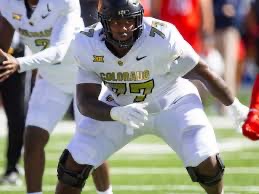
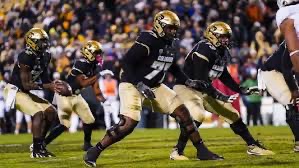
Returning Players:
Colorado returns the following players from last year’s roster:
- G Tyler Brown (6’3” 310 pounds). Brown really struggled last season. His PFF run blocking score was the lowest among offensive lineman with meaningful snaps last year, and his pass protection grades weren’t materially better. In his defense, however, he played almost every position along the offensive line and didn’t have a true “home” position. Brown is probably the strongest player in the program, and once he locks onto defenders he has success moving them off the line of scrimmage. However, he needs to work on his balance and footwork. If he can do those things, he can be a positive addition to the offensive line.
- G Yahya Attia (6’4” 330 pounds). One of the only players in college football born in Egypt, the London NFL Academy graduate is still raw. However, he has great size and a nasty disposition, as seen in Well Off Video 1-on-1 drills. The sophomore-to-be is still learning to play the game. While he may not earn meaningful playing time this year, he could take a leap and be a key member of the line as an upperclassman.
- G Zach Owens (6’6” 375 pounds). Owens played limited snaps last season and is a bit of a mystery man. The 4-star former Clemson guard has the size to dominate inside. This next year will be crucial for the sophomore-to-be to see if he can earn meaningful playing time or whether he’ll be a depth piece going forward.
- C Cash Cleveland (6’3” 300 pounds). Cleveland seemingly came out of nowhere (technically he’s straight out of IMG Academy) to unseat returning starter Hank Zlinskas mid-season and improve the offensive line. The heady walk-on went on to have the highest PFF score among the returning offensive lineman in the program and he surprised fans with his pass blocking ability. Fans that think he’s just a body are wrong – the man named Cash that is built like an ATM can play.
- T Ben Reznik (6’6” 295 pounds). Reznik, like the Human ATM, is a walk-on. He moved into the starting lineup at the end of the year after injuries to Phillip Houston and really, really struggled pass blocking. Reznik is a hard worker and has made the most of his opportunity at Colorado and hopefully is a depth player going forward.
- T Philip Houston (6’5” 270 pounds). The senior-to-be Houston was a surprisingly good run blocker at right tackle given his size, and his overall PFF score is higher than Jordan Seaton’s PFF score last year. Still, he struggled in pass protection and can get out-muscled. If Houston can put on 20+ pounds over the off-season, then he might be in prime position to start game 1 at right tackle.
- G Kareem Harden (6’5” 315 pounds). Harden is a senior-to-be but may have an additional year of eligibility after the upcoming season due to a new ruling allowing former junior college players another year to compete. Harden noticeably improved over the course of last season, and his PFF scores reflect this development. Harden’s first couple performances were not strong. However, he came on strongly at the end of the season and posted pass blocking scores of 87.6 (at Kansas), 68.7 (against Oklahoma State) and 90.5 (vs. BYU) over the last 3 games of the year. If he can continue this progress, he’ll be a starter next season and a potential All Big-12 player.
- Jordan Seaton (6’5” 285 pounds). Seaton was a workhorse for the Buffs last year, playing over 850 snaps — far and away the most snaps played among CU offensive linemen. This was in part due to his talent but also due to a complete lack of depth at the tackle position. The workload took a toll on Seaton, and his performance dropped in the final third of the season. This is not surprising for an athlete that just 10 months earlier was playing high school football. The toll of playing every snap on an offensive line in a Power 4 conference as an 18/19 year old is real. In any event, it is clear that Seaton has unique physical gifts and can be a very special player at Colorado. Colorado needs him to take a step and be the dominant leader of this group next season. He can do it.
Incoming Transfers:
Additionally, Colorado had the following transfers into the program this off-seasson:
- Zarian McGill (transfer from LA Tech). McGill is ready to walk onto the field and start at center for CU. He played last season at Louisiana Tech and graded out at 71.4, and was the highest ranked Bulldogs’ offensive lineman (and a higher ranking than any CU offensive linemen last year). The prior year, he was named second-team all-Sun Belt as a fourth-year junior at Louisiana Monroe. Expect McGill to start at center for the Buffs against Georgia Tech on August 30th. McGill and The Human ATM will push each other and should cause the center position to be a position of strength for the offense.
- Zy Crisler (transfer from Illinois). Crisler is a 6’6”, 336-pound guard from Illinois. Crisler started 6 games at right guard in 2024 before being replaced by Brandon Henderson mid-season. The previous 2 seasons, however, Crisler was named honorable mention All Big-10. Crisler has an extra year of eligibility due to the junior college ruling and decided to spend it at Colorado. Crisler’s PFF scores have not been strong over the last 3 years (he’s had overall grades of 50.1, 57.3 and 52.4, which would put him slightly below Tyler Brown’s grade, for example). Expect Crisler to push for playing time at left guard.
- Mana Taimani (transfer from Ole Miss). Taimani is a 6’4”, 345 pound lineman that has primarily played on special teams for his career. He played in 4 games this past season at Ole Miss and 11 games the previous season. Taimani has spent playing time at every position on the offensive line except for center, so he will provide depth for the Buffs up front. He has played only 43 snaps over the last 3 seasons, however, so any production from Taimani will be positive for Colorado.
- Aki Ogunbiyi (transfer from TAMU). The 6’4” 330 pound Ogunbiyi has started 8 games over the previous 3 seasons at Texas A& (with 0 starts last year, 4 starts in 2023 and 4 starts in 2022). His PFF scores over the prior 3 seasons are 64.4, 47.5, and 51.2. Expect Ogunbiyi to provide good depth at tackle, something that was missing from Colorado’s tackles this past season.
Colorado added 3 freshman offensive linemen as well – Chauncey Gooden, Carde Smith and Jay Gardenhire. (All of them have received or will receive Hello! Posts this off-season). 99% of the time it is better for a freshman offensive lineman to redshirt. This enables the young player to get strong enough to compete at the collegiate level. There are exceptions, however — see Jordan Seaton and the Human ATM last year. It is possible that both Gooden and Smith see material playing time this fall as they are both very high-upside players and probably more talented than many of the upperclassmen above them. However, the leap to college is probably the most difficult for high school offensive linemen, and the hope here is that the upperclassmen have progressed enough that we don’t need to see the true freshmen playing regularly this fall.
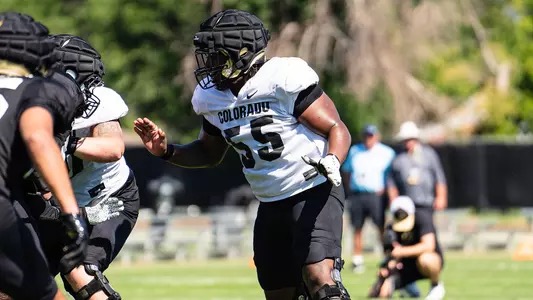
Outgoing Transfers:
Colorado had 4 offensive linemen transfer out of the program. The primary loss here is Kahlil Benson (transferring back to Indiana). Benson was arguably one of the Buffs best offensive linemen last season and he had a 70 rating on PFF. Other transfers include Hank Zlinskas (to Rutgers to join his brother), Yakiri Walker (to Memphis)., Tyler Johnson (uncommitted), and Payton Kirkland (to Miami (Ohio)) (so no, not that Miami).
Projected 2-Deep:
RT: Phillip Houston / Aki Ogunbiy
RG: Kareem Harden / Tyler Brown
C: Zarian McGill / Cash Cleveland
LG: Zy Crisler / Tyler Brown
LT: Jordan Seaton / Aki Ogunbiyi
Final Thoughts:
The projected offensive line for 2025 looks a lot like last year’s offensive line — which may not be a terrible thing. However, given the need for the line to take a big step forward this season to become a strength of the team (largely due to the loss of Sanders and Hunter), the hope is that there is material improvement among the returnees. Left guard (and, to a lesser extent, right tackle) doesn’t appear to be a position of strength. Perhaps Colorado will still look to add to these positions in the Spring Transfer Portal. It also wouldn’t shock if Chauncey Gooden and Carde Smith are playing meaningful minutes in the 2nd half of the season which speaks to their potential (as well as potential weakness among returnees and transfers at LG and RT). In any event, for this team to be successful, the offensive line is going to need to learn how to run block much more effectively. It remains an open question as to whether the current group of players will be able to have more success running the ball. It also becomes absolutely critical that the team hires a proven and experienced offensive line coach to get the most out of the current players.
The higher priority is to hire a quality coach for this position!
Thanks for sharing line up, you make this interesting. 👏👏
This is the best analysis on our 2025 line this offseason. I appreciate that you contextualized these players’ performances with actual statistics. For example, the Buffs fanbase has been huge on Zy Crisler, yet after reading this, he graded out about the same as Tyler Brown!! LOL. Granted that it is against the Big 10 comp, he will hopefully be able to have better success in this conference. Regardless, this leaves a clear goal in my eyes in the spring transfer portal. We have addressed the offensive line depth, now if we can just target one quality, big-bodied, guard or right tackle, with experience, that would really jump the quality of this room. I am actually okay with having Phillip Houston come back and take the right tackle position again this year. My next area of concern is linebacker depth, however that is not what this post is discussing.
Thanks Kiefer. Appreciate the kind words. I agree that we have depth — now we need one high quality starter.
Pingback: COLORADO SPRING FOOTBALL 2025: WHAT WE’RE HEARING ABOUT THE OFFENSE - BuffsBlog.com